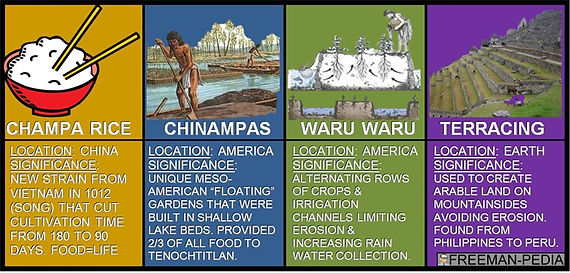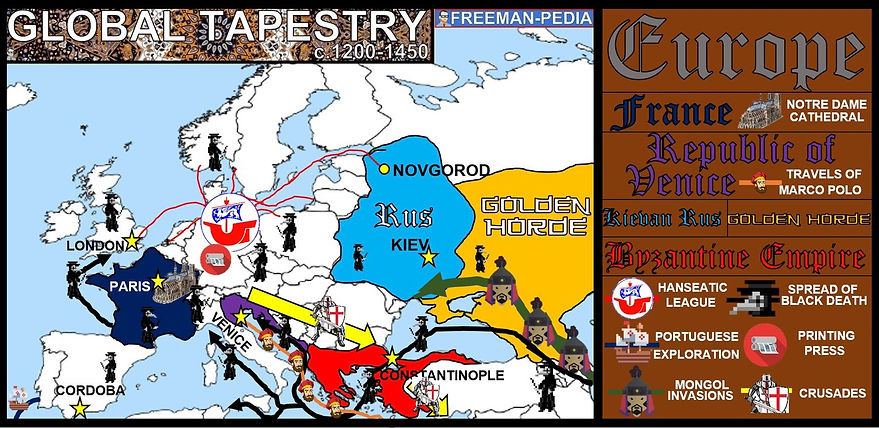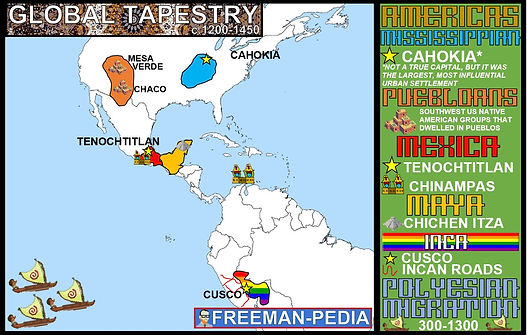
.jpg)
Though Afro-Eurasia and the Americas remained separate from each other, this era witnessed a deepening and widening of old and new networks of human interaction within and across regions. The results were unprecedented concentrations of wealth and the intensification of cross-cultural exchanges. Innovations in transportation, state policies and mercantile practices contributed to the expansion and development of commercial networks, which in turn served as conduits for cultural, technological, and biological diffusion within and between various societies. Pastoral or nomadic groups played a key role in creating and sustaining these networks. Expanding networks fostered greater inter-regional borrowing while at the same time sustaining regional diversity. Significantly, Islam, a major religion, emerged at the start of this period and spread quickly through practices of trade, warfare, and diffusion characteristic of this period.
I. Improved transportation technologies and commercial practices led to an increased volume of trade, and expanded the geographical range of existing and newly-active trade networks.
A. Existing trade routes flourished and promoted the growth of powerful new trading cities (Novgorod,Timbuktu, Swahili city-states, Hangzhou, Calicut, Baghdad, Melaka, Venice, Tenochtitlan,Cahokia.)
B. New trade routes between Mesoamerica and the Andes developed.
C. The growth of inter-regional trade in luxury goods (such as silk and cotton textiles, porcelain, spices, precious metals and gems, slaves or exotic animals) was encouraged by significant innovations in previously-existing transportation and commercial technologies, including more sophisticated caravan organization (such as caravanserai or camel saddles), use of the compass, astrolabe, and larger ship designs in sea travel, and new forms of credit and monetization (such as bills of exchange, credit, checks or banking houses).
D. Commercial growth was also facilitated by state practices (such as the minting of coins or use of paper money), trading organizations (such as the Hanseatic League), and state-sponsored commercial infrastructures like the Grand Canal in China.
.jpg)
.jpg)
Key Concept 3.1 Expansion and Intensification of Communication and Exchange Networks


.png)
E. The expansion of existing empires—including China, the Byzantine Empire, and the Caliphates—as well as new empires—like the Mongols—facilitated trans-Eurasian trade and communication as new peoples were drawn into their conquerors’ economies and trade networks.
Early African Civilization
Islamic
Caliphates
Mongol
Empire
Byzantine
Empire
Imperial China
Empires To Know


Some migrations had a significant environmental impact. Required examples of migration and their environmental impact:
-
The migration of Bantu-speaking peoples who facilitated transmission of iron technologies and agricultural techniques in Sub-Saharan Africa (Click here to follow the Migrations)
-
The maritime migrations of the Polynesian peoples who cultivated transplanted foods and domesticated animals as they moved to new islands

3. Cross-cultural exchanges were fostered by the intensification of existing, or the creation of new, networks of trade and communication.
-
Islam, based on the revelations of the prophet Muhammad, developed in the Arabian peninsula. The beliefs and practices of Islam reflected interactions among Jews, Christians, and Zoroastrians with the local Arabian peoples. Muslim rule expanded to many parts of Afro-Eurasia due to military expansion, and Islam subsequently expanded through the activities of merchants and missionaries
-
In key places along important trade routes, merchants set up diasporic communities (Muslim merchant communities in the Indian Ocean region, Chinese merchant communities in Southeast Asia, Sogdian merchant communities throughout Central Asia, Jewish communities in the Mediterranean, Indian Ocean Basin, or along the silk roads)where they introduced their own cultural traditions into the indigenous culture.
-
The writings of certain interregional travelers (Ibn Battuta, Marco Polo, Xuanzang)illustrate both the extent and the limitations of intercultural knowledge and understanding.

-
Increased cross-cultural interactions resulted in the diffusion of literary, artistic, and cultural traditions (Neoconfucianism and Buddhism in Southeast Asia, Hinduism and Buddhism in Southeast Asia, Islam in Sub-saharan Africa and Southeast Asia, Toltec/Mexica and Inca traditions in Mesoamerica and Andean America).
-
Increased cross-cultural interactions also resulted in the diffusion of scientific and technological traditions (Greek and Indian mathematics on Muslim scholars, return of Greek science and philosophy to Western Europe via Muslim al-Andalus in Iberia, Spread of printing and gunpowder technologies from East Asia into the Islamic empires and Western Europe).
4. There was continued diffusion of crops and pathogens throughout the Eastern Hemisphere along the trade routes.
-
New foods and agricultural techniques (Bananas in Africa, New rice varieties in East Asia, Spread of Cotton, sugar, and citrus throughout Dar-al-Islam and the Mediterranean basin)were adopted in populated areas.
-
The spread of epidemic diseases, including the Black Death, followed the well established paths of trade and military conquest
Key Concept 3.2. Continuity and Innovation of State Forms and Their Interactions
State formation in this era demonstrated remarkable continuity, innovation and diversity in various regions. In Afro-Eurasia, some states attempted, with differing degrees of success, to preserve or revive imperial structures, while smaller, less centralized states continued to develop. The expansion of Islam introduced a new concept — the Caliphate — to Afro-Eurasian statecraft. Pastoral peoples in Eurasia built powerful and distinctive empires that integrated people and institutions from both the pastoral and agrarian worlds. In the Americas, powerful states developed in both Mesoamerica and the Andean region.
1. Empires collapsed and were reconstituted; in some regions new state forms emerged.
-
Following the collapse of empires, most reconstituted governments, including the Byzantine Empire and the Chinese dynasties — Sui, Tang, and Song — combined traditional sources of power and legitimacy (Patriarchy, Religion, Land-owning elites) with innovations (New methods of taxation, Tributary systems, Adaptation of Religious Institutions) better suited to the current circumstances.
Byzantine
Empire
Imperial China
-
In some places, new forms of governance emerged, including those developed in various Islamic states (Abassids, Muslim Iberia, Dehli Sultanates), the Mongol Khanates, city-states (Italian Peninsula, East Africa, Southeast Asia, Americas), and decentralized government (feudalism) in Europe and Japan.
.jpg)
Mongol
Empire
Islamic
Caliphates
-
Some states synthesized local and borrowed traditions (Persian traditions that influenced Islamic States, Chinese traditions that influenced Japan)
-
In the Americas, as in Afro-Eurasia, state systems expanded in scope and reach: Networks of city-states flourished in the Maya region and, at the end of this period, imperial systems were created by the Mexica (“Aztecs”) and Inca

We are the Exception..
2. Interregional contacts and conflicts between states and empires encouraged significant technological and cultural transfers.
-
Required examples of technological and cultural transfers
-
Between Tang China and the Abbasids at the Battle of Talas
-
Across the Mongol empires
-
During the Crusades
-
.jpg)
Key Concept 3.3. Increased Economic Productive Capacity and Its Consequences
Changes in trade networks resulted from and stimulated increasing productive capacity, with important implications for social and gender structures and environmental processes. Productivity rose in both agriculture and industry. Rising productivity supported population growth and urbanization but also strained environmental resources and at times caused dramatic demographic swings. Shifts in production and the increased volume of trade also stimulated new labor practices, including adaptation of existing patterns of free and coerced labor. Social and gender structures evolved in response to these changes.
1. Innovations stimulated agricultural and industrial production in many regions.
-
Agricultural production increased significantly due to technological innovations (Champa rice varieties,chinampa field systems, Waru waru agricultural techniques in the Andean areas, Improved terracing techniques, horse collar
-
In response to increasing demand in Afro-Eurasia for foreign luxury goods, crops were transported from their indigenous homelands to equivalent climates in other regions.
-
Chinese, Persian, and Indian artisans and merchants expanded their production of textiles and porcelains for export; industrial production of iron and steel expanded in Chin
2. The fate of cities varied greatly, with periods of significant decline, and with periods of increased urbanization buoyed by rising productivity and expanding trade networks.
A. Factors that contributed to declines of urban areas in this period included invasions, disease, the decline of agricultural productivity, and the Little Ice Age.
B. Factors that contributed to urban revival included the end of invasions, the availability of safe and reliable transport, the rise of commerce and the warmer temperatures between 800 and 1300. Increased agricultural productivity and subsequent rising population and greater availability of labor also contributed to urban growth.
C. While cities in general continued to play the roles they had played in the past as governmental, religious and commercial centers, many older cities declined at the same time that numerous new cities took on these established roles.


3. Despite significant continuities in social structures and in methods of production, there were also some important changes in labor management and in the effect of religious conversion on gender relations and family life.
-
As in the previous period, there were many forms of labor organization. Required examples of forms oflabor organization
-
Free peasant agriculture
-
Nomadic pastoralism
-
Craft production and guild organization
-
Various forms of coerced and unfree labor
-
Government-imposed labor taxes
-
Military obligations
-
-
As in the previous period, social structures were shaped largely by class and caste hierarchies. Patriarchy persisted; however, in some areas,women exercised more power and influence, most notably among the Mongols and in West Africa, Japan, and Southeast Asia.
-
New forms of coerced labor appeared, including serfdom in Europe and Japan and the elaboration of the mit’a in the Incan Empire.
-
Free peasants resisted attempts to raise dues and taxes by staging revolts. The demand for slaves for both military and domestic purposes increased, particularly in central Eurasia, parts of Africa, and the eastern Mediterranean.
-
The diffusion of Buddhism, Christianity, Islam, and Neoconfucianism often led to significant changes in gender relations and family structure
.jpg)
.jpg)
.jpg)
.jpg)
.jpg)




2. The movement of peoples caused environmental and linguistic effects.
-
The expansion and intensification of long-distance trade routes often depended on environmental knowledge and technological adaptations to it (Scandinavian Vikings used their longships to travel in coastal and open waters as well as in rivers and estuaries,Arabs and Berbers adapted camels to travel across and around the Sahara, Central Asian pastoral groups used horses to travel in the steppes).

And this guy
Unit 3 Post Classical
Unit 3 Post Classical


History Summarized: The Maya, Aztec, and Inca

Columbus, Vasco da Gama, and Zheng He - 15th Century Mariners: Crash Course World History #21

Early Medieval Trade | World History | Khan Academy
New AP World Maps

Brought to you by
Freemanpedia










.jpg)








.jpg)


.png)
.png)